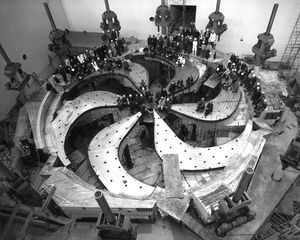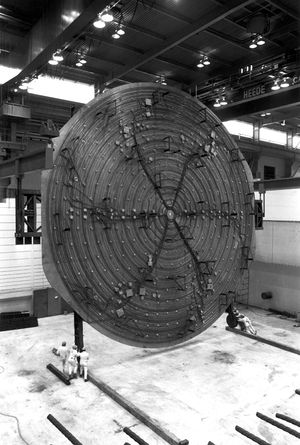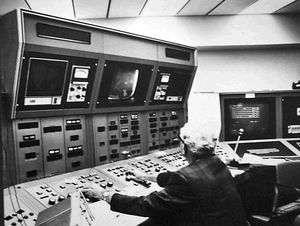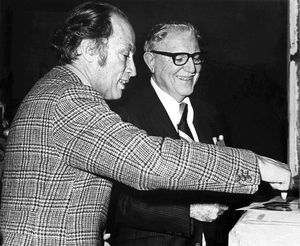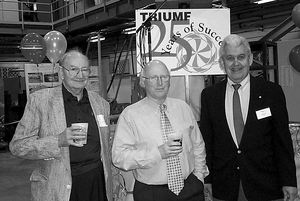Milestone-Nomination:First 500 MeV proton beam from the worlds largest cyclotron: Difference between revisions
Dmichelson (talk | contribs) m (Added File Attachment TRIUMF-inside_the_cyclotron.jpg) |
Dmichelson (talk | contribs) m (Added File Attachment TRIUMF-site5.jpg) |
||
| Line 83: | Line 83: | ||
== Please attach a letter in English, or with English translation, from the site owner giving permission to place IEEE milestone plaque on the property. == | == Please attach a letter in English, or with English translation, from the site owner giving permission to place IEEE milestone plaque on the property. == | ||
''The letter is necessary in order to process your nomination form. Click the Attachments tab to upload your letter.'' <br><br>[[Media:IEEE-Milestone-Support-TRIUMF.pdf|IEEE-Milestone-Support-TRIUMF.pdf]]<br>[[Media:CL9-vacuum.jpg|CL9-vacuum.jpg]]<br>[[Media:CL-11-sitting_down.jpg|CL-11-sitting_down.jpg]]<br>[[Media:CL26_500Mev.jpg|CL26_500Mev.jpg]]<br>[[Media:CL-5-pierre_trudeau.jpg|CL-5-pierre_trudeau.jpg]]<br>[[Media:CL25-silver_anniversary.jpg|CL25-silver_anniversary.jpg]]<br />[[Media:99-users9_600m_600hyp.pdf|99-users9_600m_600hyp.pdf]]<br />[[Media:TRIUMF-inside_the_cyclotron.jpg|TRIUMF-inside_the_cyclotron.jpg]] | ''The letter is necessary in order to process your nomination form. Click the Attachments tab to upload your letter.'' <br><br>[[Media:IEEE-Milestone-Support-TRIUMF.pdf|IEEE-Milestone-Support-TRIUMF.pdf]]<br>[[Media:CL9-vacuum.jpg|CL9-vacuum.jpg]]<br>[[Media:CL-11-sitting_down.jpg|CL-11-sitting_down.jpg]]<br>[[Media:CL26_500Mev.jpg|CL26_500Mev.jpg]]<br>[[Media:CL-5-pierre_trudeau.jpg|CL-5-pierre_trudeau.jpg]]<br>[[Media:CL25-silver_anniversary.jpg|CL25-silver_anniversary.jpg]]<br />[[Media:99-users9_600m_600hyp.pdf|99-users9_600m_600hyp.pdf]]<br />[[Media:TRIUMF-inside_the_cyclotron.jpg|TRIUMF-inside_the_cyclotron.jpg]]<br />[[Media:TRIUMF-site5.jpg|TRIUMF-site5.jpg]] | ||
Revision as of 21:08, 9 January 2010
Docket Number: 2009-08
Proposal Link: https://ethw.org/Milestone-Proposal:First_500_MeV_proton_beam_from_the_worlds_largest_cyclotron
Proposed Citation
First 500 MeV Proton Beam from the World's Largest Cyclotron, 1974
At 3:30 pm on 15 December 1974, the first 500 MeV proton beam was extracted from the TRIUMF cyclotron. Since then, TRIUMF has used proton beams from its cyclotron (and secondary muon and pion beams produced in its experimental halls) to conduct pioneering studies that have advanced nuclear physics, particle physics, molecular and materials science, and nuclear medicine.
The plaque will be installed outside the cyclotron main control room near the site dedication plaque. (The first successful beam extraction was manually controlled from the main console in that room.)
Historical Photographs
(provided by the TRIUMF Laboratory)
Significance
The TRIUMF Laboratory
TRIUMF is Canada’s national laboratory for particle and nuclear physics. It is owned and operated as a joint venture by a consortium of Canadian universities. Its operations are supported by a contribution from the National Research Council Canada while capital funds for buildings are provided by the Government of British Columbia.
TRIUMF's mission is:
- To make discoveries that address the most compelling questions in particle physics, nuclear physics, nuclear medicine, and materials science;
- To act as Canada’s steward for the advancement of particle accelerators and detection technologies; and
- To transfer knowledge, train highly skilled personnel, and commercialize research for the economic, social, environmental, and health benefit of all Canadians.
More information concerning the TRIUMF Laboratory can be found at http://www.triumf.ca
The 500 MeV Cyclotron
The heart of the TRIUMF Laboratory is the 500 MeV cyclotron that was conceived, designed, constructed and commissioned between 1965 and 1974. The early history of TRIUMF is described in:
M.K. Craddock, "The First Beam - A Whirlwind Visual History - and Prehistory," Annual General Meeting of the TRIUMF Users’ Group, 13 December 1999.
Compared to the first and second generation of cyclotrons that provided much lower beam energies and intensities, the physical size of the 500 MeV is truly impressive. The main magnet is 18 metres in diameter and weighs 4000 tons. The 23 MHz main RF amplifier delivers almost 1 million watts of power in order to develop 200 kV across the accelerating gap.
The sheer scale of the design and construction effort required TRIUMF staff and contractors to develop revolutionary computer-assisted design, modelling, measurement and tuning technologies in an era dominated by mainframes and minicomputers. Some of these codes, e.g., RELAX3D - a Laplace and Poisson equation solver, are still in use today.
Because of its size, TRIUMF was one of the first particle accelerators to employ a software-based supervisory control and data acquisition system rather than direct linkage of cyclotron and beamline components to a hardware-based control panel.
By providing intermediate energy proton beams that are two orders of magnitude more intense than were previously available, the TRIUMF cyclotron (and its two sister meson factories in the United States and Europe) have revolutionized nuclear physics, particle physics, molecular and materials science, and nuclear medicine.
Subsequent Developments at the TRIUMF Laboratory
The quality of the initial design and engineering and the significance of the result are underscored by the longevity of the TRIUMF cyclotron. Thirty-five years after the first 500 MeV proton beam was extracted, the cyclotron is still the main engine of TRIUMF’s world-leading research program which currently includes meson physics, nuclear physics, nuclear astrophysics, nuclear medicine and irradiation services for industry.
KAON
ISAC
ATLAS
TTO
AAPS
Distinguishing features or characteristics of this work
TRIUMF is the world's largest cyclotron, and one of only three intermediate-energy high-intensity accelerators in the world. The TRIUMF design team pioneered the production and acceleration of H- ions and the use of an AVF (azimuthally varying field) main magnet.
Unlike the world's other two intermediate-energy high-intensity accelerators (located near Zurich and Los Alamos, respectively), the TRIUMF cyclotron can deliver both low-intensity variable energy proton beams and high intensity intermediate energy proton beams with a 100% macroscopic duty cycle.
The high intensity of the beam allows the cyclotron to serve as the driver for multiple experiments within the course of a week. The TRIUMF cyclotron’s ability to provide steady, intense and reliable energy beams in a flexible manner has also allowed the facility to become a world leader in providing beams of exotic isotopes using the "isotope separation online" technique.
This nomination was prepared by:
Prof. Dave Michelson, University of British Columbia, davem@ece.ubc.ca , and
Dr. Tim Meyer, TRIUMF, tmeyer@triumf.ca .
Please attach a letter in English, or with English translation, from the site owner giving permission to place IEEE milestone plaque on the property.
The letter is necessary in order to process your nomination form. Click the Attachments tab to upload your letter.
IEEE-Milestone-Support-TRIUMF.pdf
CL9-vacuum.jpg
CL-11-sitting_down.jpg
CL26_500Mev.jpg
CL-5-pierre_trudeau.jpg
CL25-silver_anniversary.jpg
99-users9_600m_600hyp.pdf
TRIUMF-inside_the_cyclotron.jpg
TRIUMF-site5.jpg
